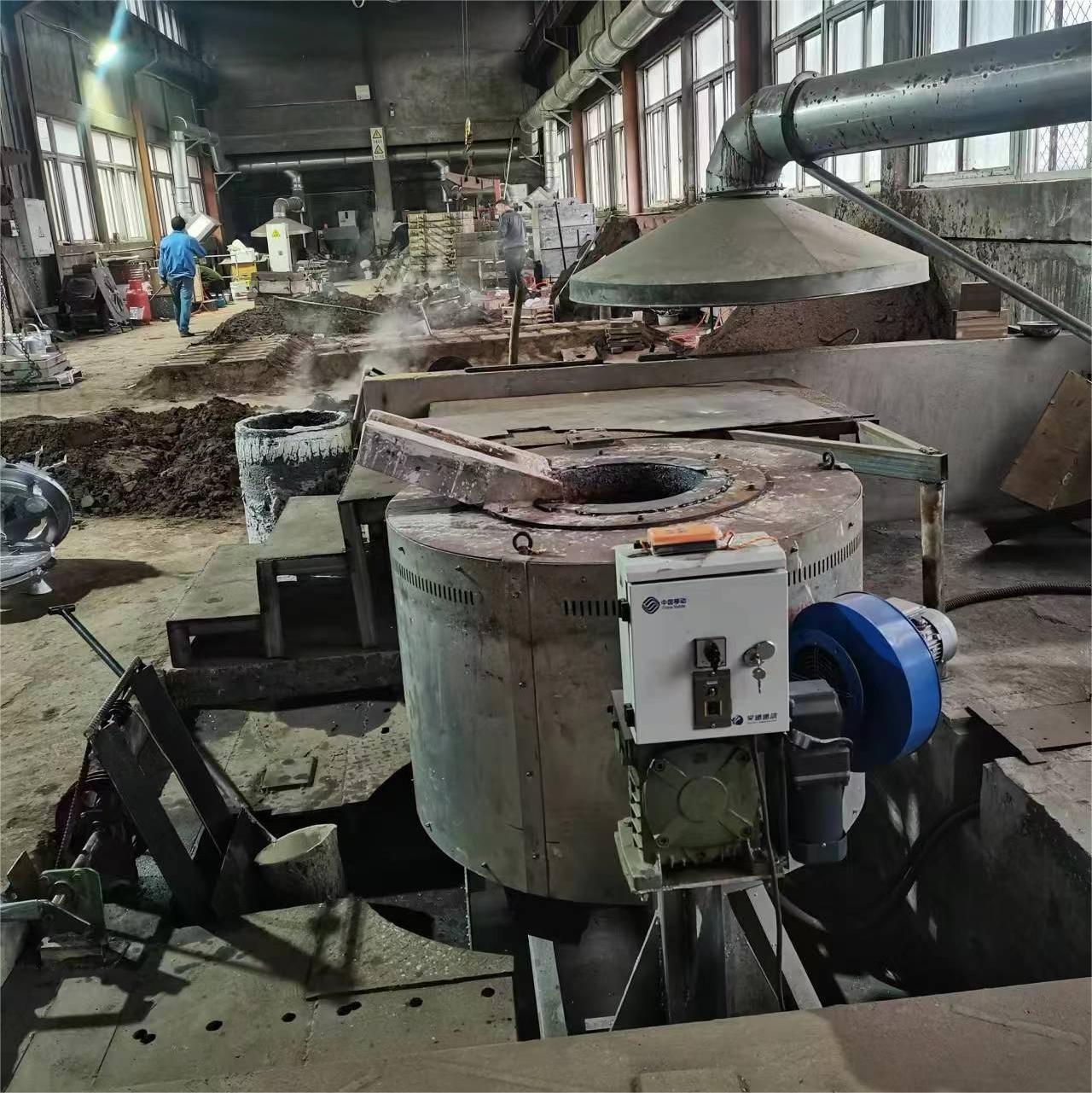130KW Tilting melting furnace For 500KG copper
Technical Parameter
Power Range: 0-500KW adjustable
Melting Speed: 2.5-3 hours/per furnace
Temperature Range: 0-1200℃
Cooling System: Air-cooled, zero water consumption
|
Aluminium Capacity |
Power |
|
130 KG |
30 KW |
|
200 KG |
40 KW |
|
300 KG |
60 KW |
|
400 KG |
80 KW |
|
500 KG |
100 KW |
|
600 KG |
120 KW |
|
800 KG |
160 KW |
|
1000 KG |
200 KW |
|
1500 KG |
300 KW |
|
2000 KG |
400 KW |
|
2500 KG |
450 KW |
|
3000 KG |
500 KW |
|
Copper Capacity |
Power |
|
150 KG |
30 KW |
|
200 KG |
40 KW |
|
300 KG |
60 KW |
|
350 KG |
80 KW |
|
500 KG |
100 KW |
|
800 KG |
160 KW |
|
1000 KG |
200 KW |
|
1200 KG |
220 KW |
|
1400 KG |
240 KW |
|
1600 KG |
260 KW |
|
1800 KG |
280 KW |
|
Zinc Capacity |
Power |
|
300 KG |
30 KW |
|
350 KG |
40 KW |
|
500 KG |
60 KW |
|
800 KG |
80 KW |
|
1000 KG |
100 KW |
|
1200 KG |
110 KW |
|
1400 KG |
120 KW |
|
1600 KG |
140 KW |
|
1800 KG |
160 KW |
Product Functions
Preset temperatures & timed start: Save costs with off-peak operation
Soft-start & frequency conversion: Automatic power adjustment
Overheat protection: Auto shutdown extends coil life by 30%
Why Choose a High-Frequency Induction Furnace?
High-Frequency Eddy Current Heating
- High-frequency electromagnetic induction directly generates eddy currents in metals
- Energy conversion efficiency >98%, no resistive heat loss
Self-Heating Crucible Technology
- Electromagnetic field heats the crucible directly
- Crucible lifespan ↑30%, maintenance costs ↓50%
PLC Intelligent Temperature Control
- PID algorithm + multi-layer protection
- Prevents metal overheating
Smart Power Management
- Soft-start protects power grid
- Auto frequency conversion saves 15-20% energy
- Solar-compatible
Applications
Benefits of Tilting Mechanism for Melting Furnaces
1. Precise Metal Flow Control
- Adjustable tilt (15°-90°) prevents splashing/spillage.
- Flow rate control for different batch sizes.
2. Enhanced Safety
- No manual handling of molten metal (>1000°C).
- Leak-proof design with emergency auto-return.
3. Higher Efficiency
- 10-second pouring (vs 1-2 mins manually).
- 5%+ less metal waste vs traditional methods.
4. Durability & Adaptability
- 1500°C-resistant materials (ceramic fiber/special alloys).
- Smart automation integration (optional).

Customer Pain Points
Resistance Furnace vs. Our High-Frequency Induction Furnace
| Features | Traditional Problems | Our Solution |
| Crucible Efficiency | Carbon buildup slows melting | Self-heating crucible maintains efficiency |
| Heating Element | Replace every 3-6 months | Copper coil lasts years |
| Energy Costs | 15-20% annual increase | 20% more efficient than resistance furnaces |
.
.
Medium-Frequency Furnace vs. Our High-Frequency Induction Furnace
| Feature | Medium-Frequency Furnace | Our Solutions |
| Cooling System | Relies on complex water cooling, high maintenance | Air cooling system, low maintenance |
| Temperature Control | Rapid heating causes overburning of low-melt metals (e.g., Al, Cu), severe oxidation | Auto-adjusts power near target temp to prevent overburning |
| Energy Efficiency | High energy consumption, electricity costs dominate | Saves 30% electric energy |
| Ease of Operation | Requires skilled workers for manual control | Fully automated PLC, one-touch operation, no skill dependency |
Installation Guide
20-minute quick installation with complete support for seamless production setup
Why Choose Us
- Improved Safety:
- The tilting function significantly reduces the risk of accidents by minimizing manual handling of the molten metal. Operators can safely pour the metal with precision, reducing splashes and spillage, which are common risks in traditional furnaces.
- Enhanced Efficiency:
- The ability to tilt the furnace eliminates the need for ladles or manual transfer, allowing for quicker and more efficient pouring operations. This not only saves time but also reduces the labor required, increasing overall productivity.
- Reduced Metal Wastage:
- The precise pouring capability of the tilting furnace ensures that the exact amount of molten metal is poured into the mold, reducing wastage and improving yield. This is especially important when working with expensive metals like gold, silver, or high-grade alloys.
- Versatile Application:
- Suitable for melting a wide range of non-ferrous metals and alloys, the tilting furnace is widely used in foundries, metal recycling plants, jewelry manufacturing, and research laboratories. Its versatility makes it an indispensable tool across various metalworking industries.
- Ease of Operation:
- The furnace's user-friendly design, coupled with automatic or semi-automatic controls, ensures that operators can manage the melting and pouring process with minimal training. The tilting mechanism can be easily controlled through a lever, switch, or hydraulic system for smooth operation.
- Cost-Effective:
- Due to its energy-efficient design, reduced labor requirements, and ability to handle high-capacity melting, the tilting melting furnace offers long-term cost savings for businesses. Its durability and low maintenance needs further enhance its cost-effectiveness.
-
- Tilting Mechanism:
- The Tilting melting furnace is equipped with a manual, motorized, or hydraulic tilting system, enabling smooth and controlled pouring of molten metal. This mechanism eliminates the need for manual lifting, enhancing operator safety and improving the accuracy of metal transfer into molds.
- High-Temperature Capability:
- The furnace can melt metals at temperatures exceeding 1000°C (1832°F), making it suitable for a variety of non-ferrous metals, including copper, aluminum, and precious metals like gold and silver.
- Energy Efficiency:
- Advanced insulation materials and energy-efficient heating elements, such as induction coils, gas burners, or electric resistance, ensure that heat is retained within the furnace chamber, reducing energy consumption and increasing melting speed.
- Large Capacity Range:
- Available in various sizes, the tilting melting furnace can accommodate different capacities, from small-scale operations for jewelry making to large industrial setups for bulk metal production. The flexibility in size and capacity makes it adaptable to various industries and production requirements.
- Precise Temperature Control:
- The furnace is equipped with an automatic temperature control system that maintains consistent heating throughout the melting process. This ensures that the molten metal reaches the ideal temperature for casting, minimizing impurities and enhancing the final product quality.
- Robust Construction:
- Made from high-grade refractory materials and durable steel housing, the furnace is designed to withstand harsh conditions, such as high temperatures and heavy use. This ensures a long service life, even in demanding industrial environments.
- Tilting Mechanism:
Frequently Asked Questions
Q1: What is the power supply for the industrial furnace?
The power supply for the industrial furnace is customizable to meet the customer's specific needs. We can adjust the power supply (voltage and phase) through a transformer or directly to the customer's voltage to ensure the furnace is ready for use at the end-user's site.
Q2: What information should the customer provide to receive an accurate quotation from us?
To receive an accurate quotation, the customer should provide us with their related technical requirements, drawings, pictures, industrial voltage, planned output, and any other relevant information.
Q3: What are the payment terms?
Our payment terms are 40% down payment and 60% before delivery, with payment in the form of a T/T transaction.

Our Team
No matter where your company is located, we are able to offer a professional team service within 48 hours. Our teams are always in high alert so your potential problems can be solved with military precision. Our employees are constantly educated so they are up to date with current market trends.













